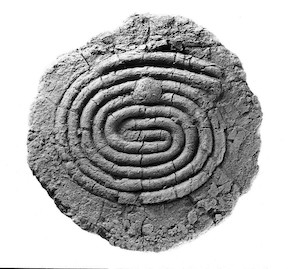“Do you have the discipline to be a free spirit?”
Great questions lead into unknown idea chambers—and this particular one posed by Roth with its paradoxical synthesis of discipline and freedom offers a key to the Saturn-Neptune sextile that is quietly humming throughout the year. Dates for the three exact contacts: January 31, June 18, and November 8.
Saturn has to do with the matter of our lives and what matters. His concern lies in our developing a skillful mastery of those things, be it practical day to day stuff or deep interior work. Saturn keeps our feet to the ground, anchoring us to the current reality. (Saturn’s Greek name was Chronos which is the root for linear time, chronological.) Whatever house he is occupying by transit in our chart is where we feel the pressure and weightiness of what really matters, demanding our attention to the tasks related to those things.
Where Saturn moors us, Neptune pulls us up to the realm of spirit. It is the Neptunian force that draws our attention to realms that transcend the here and now, and those portals can be most anything—unifying ideas and philosophies, creative inspiration, dreams, altered states of consciousness and even madness. And with Neptune in its own sign of Pisces, it makes possible a more sensitized awareness to the realm of the spirit in its various guises.
What does the conversation between these two archetypal forces look like in life? While there are many forms that can convey this dynamic, what captures my imagination is dance. Recently I have watched a number of dance documentaries and I found one artist that bewitched me—Margot Fonteyn, the great British ballerina. In what is an extraordinary synchronicity, May 18th, the day I began to compose this article, would have been Fonteyn’s 100th birthday.
To watch Fonteyn dance is to witness something of the Neptunian spirit flow down through the vessel of her body. She exhibits an extraordinary physical control and a simultaneous surrender to the animating spirit. She is free and yet intensely embodied. Soaring in flight and tethered to the ground, she defies gravity with beauty. It is the Saturnian discipline of flesh and bone that makes possible this incarnation of the Neptunian vision, where the ineffable is made manifest, and it is breathtaking. In her biographer’s words:
“How to put something so visual, so potent with theatrical moment that even film cannot capture it, into plain words? How to explain why it is that when, to a particular strain of music, an ordinary mortal steps forward on one leg, raises the other behind her and lifts her arms above her head, the angels hold their breath?”
Another image of this archetypal combination is Ariadne who was also known to be a beautiful dancer. In the powerful novel Circe, Circe is walking through the palace of Knossos and stops to regard a courtyard.
“In it was a great dancing circle, ringed by laurels and oaks for shade from the beating sun. I had thought its floor was made of stone, but now I saw it was wood, a thousand tiles of it, so smoothed and varnished that they seemed like a single piece. They were painted with a spiral, traveling outwards from its center like the furling crest of a wave. Daedalus’ work, it could be no other.
A girl was dancing on it. No music played, yet her feet kept perfect time, each step the beat of a silent drum. She moved like a wave herself, graceful, but with relentless, driving motion.”
It is Ariadne who is dancing the sacred spiral, for she is the priestess of the labyrinth mysteries. The labyrinth is a great Saturnian metaphor for life, with its restrictive twists and turns, bounded paths, dark corners and dead ends leading us, through endurance to a hidden goal. As its priestess, Ariadne is the keeper of the red thread that can keep one from becoming irrevocably lost on the labyrinthine path, as it is her thread that weaves in and out, guiding one into the mystery and out again. Holding to her thread, we are given a means to make the connection between spirit and matter – between the matter of our lives and something of the ineffable spirit that suffuses it. It is this conjunction of spirit and matter that expresses one face of the Saturn-Neptune pair.
Let us imagine Ariadne’s dancing thread as Neptune’s sextile to Saturn, calling our attention to an opportunity to weave something of the ineffable and magical Neptunian realm into our perspective and experience of the Saturnian matters of our lives at this time. Look to the houses these planets are transiting so to draw out the Neptune thread to be woven into those life matters Saturn is working. If you have the discipline, portals for the spirit can open.
Babylonian spiral labyrinth, 2000 BC
Works Cited
Daneman, M. (2004). Margot Fonteyn, New York, NY: Viking.
Miller, M. (2018). Circe, New York, NY: Little, Brown and Company.

